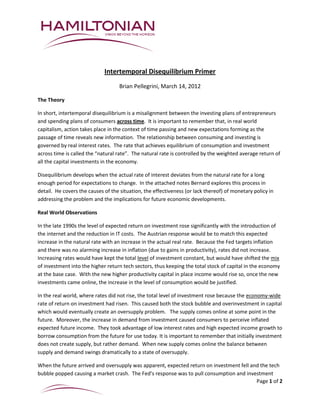
Bp 03 14 12 Intertemporal Disequilibrium Primer
- 1. Intertemporal Disequilibrium Primer Brian Pellegrini, March 14, 2012 The Theory In short, intertemporal disequilibrium is a misalignment between the investing plans of entrepreneurs and spending plans of consumers across time. It is important to remember that, in real world capitalism, action takes place in the context of time passing and new expectations forming as the passage of time reveals new information. The relationship between consuming and investing is governed by real interest rates. The rate that achieves equilibrium of consumption and investment across time is called the “natural rate”. The natural rate is controlled by the weighted average return of all the capital investments in the economy. Disequilibrium develops when the actual rate of interest deviates from the natural rate for a long enough period for expectations to change. In the attached notes Bernard explores this process in detail. He covers the causes of the situation, the effectiveness (or lack thereof) of monetary policy in addressing the problem and the implications for future economic developments. Real World Observations In the late 1990s the level of expected return on investment rose significantly with the introduction of the internet and the reduction in IT costs. The Austrian response would be to match this expected increase in the natural rate with an increase in the actual real rate. Because the Fed targets inflation and there was no alarming increase in inflation (due to gains in productivity), rates did not increase. Increasing rates would have kept the total level of investment constant, but would have shifted the mix of investment into the higher return tech sectors, thus keeping the total stock of capital in the economy at the base case. With the new higher productivity capital in place income would rise so, once the new investments came online, the increase in the level of consumption would be justified. In the real world, where rates did not rise, the total level of investment rose because the economy-wide rate of return on investment had risen. This caused both the stock bubble and overinvestment in capital which would eventually create an oversupply problem. The supply comes online at some point in the future. Moreover, the increase in demand from investment caused consumers to perceive inflated expected future income. They took advantage of low interest rates and high expected income growth to borrow consumption from the future for use today. It is important to remember that initially investment does not create supply, but rather demand. When new supply comes online the balance between supply and demand swings dramatically to a state of oversupply. When the future arrived and oversupply was apparent, expected return on investment fell and the tech bubble popped causing a market crash. The Fed’s response was to pull consumption and investment Page 1 of 2
- 2. forward from the future by further reducing real rates. This caused overconsumption fueled by imaginary gains from overinvestment in housing stock. Once rates began to rise, consumption and investment stopped being brought forward from the future. Once again expected return on investment fell as an oversupply developed again and we had an even larger market crash in 2008. Thus we see the result of disequilibrium. The Fed must keep a Ponzi game going constantly bringing consumption and investment forward by pushing interest rates lower and lower. Once real rates stop going down (even if they are at a low level or even negative), the stock of capital is revealed as being too high and a “liquidation” process – of the sort that produced the Great Depression in the early 1930s – is set in motion. * Connolly Insight, LP. This message and the information contained therein is intended only for the use of the person or persons to whom it is addressed (the intended recipient). It may contain information that is privileged and confidential within the meaning of applicable law. If you are not the intended recipient, please contact the sender a soon as possible. You should not copy it or use it for any purpose or disclose its contents to any other person via any form of media. The views expressed or implied in this communication are those of the author and may not necessarily be the views held by Hamiltonian Associates, Ltd. The content of this message does not constitute, and should not be construed as, investment research or advice. Hamiltonian Associates, Ltd reserves the right to monitor all e-mails within its network. You are advised to carry out your own virus checks on any attachments to this message. Hamiltonian Associates, Ltd does not accept liability for any loss or damage caused by software viruses. Page 2 of 2